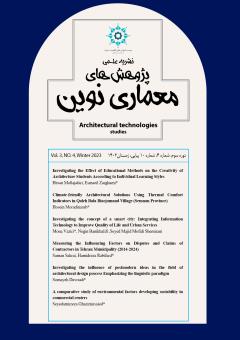Investigating the influence of postmodern ideas in the field of architectural design process Emphasizing the linguistic paradigm
Subject Areas :
1 - Department of Architecture, Technical and Vocational University, Tehran, Iran
Keywords: Architectural design process, Postmodern, Linguistics, Semantics, Paradigm.,
Abstract :
The effect of the attitude and currents of postmodernism in all fields, including architecture, has been studied and paid attention to by researchers. In this era, the combination and mutual influence of fields such as philosophy, psychology and linguistics on architectural theories has caused the formation of new perspectives, but so far, less research has specifically addressed the relationship between the field of design process and postmodern theories. On the other hand, in the postmodern era, with the strengthening of semantic theories and its influence in architectural theories under the title of "linguistic paradigm", attention was directed to the architectural concept. Based on the above necessity, the aim of this article is to strengthen ideation in the architectural design process and tries to compare the two by explaining the models of the design process and the paradigms of the postmodern era, and by emphasizing the simultaneous emergence and formation of these ideas that play a fundamental role In the process of architectural design, provide methods. This research is of a qualitative type and is based on the study of written library documents, review of previous books and researches, and then their description and analysis. The theoretical foundations of the research include the philosophy of postmodernism, theories and models of the design process, and finally the paradigm of linguistics. Logical reasoning method has been used for comparison and conclusion and the findings of the research are presented in a graph. The results of this analysis show that paying more attention to the paradigm of linguistics can help to strengthen semantics in the architectural design process and, from this point of view, lead architecture to greater conceptual richness.
1- احمدی، زهرا؛ و ذوالفقارزاده، حسن(1401). تحلیلی بـر چگونگی بیان معنا در معماری پستمدرن از دریچه زبانشناسی (مقایسه تطبیقی کاربرد فنون بلاغی در زبـان و معماری پستمدرن). معماری و شهرسازی ایران، 13(23)، 180-165. doi:10.30475/isau.2020.216256.1345
2- جنکز، چارلز(1398). زبان معماری پستمدرن. ترجمه احسان حنیف. تهران: انتشارات فکر نو.
3- داودی، س.، آیتاللهی، س. م. (1387). استعاره چیست و چگونه در تولد طرح مایه اثر میگذارد؟ صفه، 17(47)، 26-17.
4- داودی، سمیه؛ لبیبزاده، راضیه؛ طهوری، نیر(1402). تبیین نظاممند مدلهای فرایند طراحی معماری از دیدگاه طراحیپژوهی، چهارمین کنفرانس ملی معماری و شهرسازی دانشبنیان، تهران.
5- رضایی، محمود(1393). آنالوطیقای طراحی: بازنگری انگارهها و پندارهها در فرایند طراحی فرم و فضا. تهران: انتشارات دانشگاه آزاد اسلامی.
6- روشن، بلقیس؛ و اردبیلی، لیلا(1391). مقدمهای بر معناشناسی شناختی. تهران: نشر علم.
7- سوهانگیر، سارا؛ و نصیرسلامی، محمدرضا(1393). الگوهای خلق فضا در معماری با تکیهبر پارادایمهای نظری پسامدرن. باغ نظر، 11(28)، 65-78.
8- شولتز، کریستیان نوربرت(1394). معنا در معماری غرب. ترجمه مهرداد قیومی بیدهندی. تهران: انتشارات فرهنگستان هنر.
9- صفاری احمدآباد، سمیه؛ صفاری، سارا؛ و زراوندیان، سید مصطفی(1397). تحلیل رویداد پسامدرنیسم در هنرهای تجسمی از نگاه داگلاس کریمپ. باغ نظر، 15(58)، 65-76.
10- الکساندر، کریستوفر(1384). یادداشت¬هایی بر ترکیب فرم. ترجمه سعید زرین¬مهر. تهران: انتشارات روزنه.
11- لاوسون، برایان(1384). طراحان چگونه میاندیشند؟ ترجمه حمید ندیمی. تهران: انتشارات دانشگاه شهيد بهشتی.
12- لنگ، جان(1381). آفرینش نظریه معماري: نقش علوم رفتاري در طراحي محیط. ترجمه علیرضا عینی¬فر. تهران: انتشارات دانشگاه تهران.
13- مندگاری، کاظم؛ ندیمی، حمید؛ مهدوی¬پور، حسین؛ و داودی، سمیه(1390). چهارچوبی برای آشکار کردن تأثیر مؤلفههای شکلدهنده طرح مایه در کارگاه طراحی معماری (مورد پژوهی: کارگاه معماری 2 کارشناسی ارشد). صفه، 21(52)، 43-52. dor: 20.1001.1.1683870.1390.21.2.4.4
14- ندیمی، حمید(1380). جستاری در فرایند طراحی معماری. دومین کنگره معماری و شهرسازی ارگ بم. 84-71.
15- نسبیت، کیت(1397). نظریههای پسامدرن در معماری. ترجمه محمدرضا شیرازی. تهران: نشر نی.
16- ونتوری، رابرت(1389). پیچیدگی و تضاد در معماری. ترجمه سید علیرضا میرترابی و محمدرضا منوچهری. تهران: سمیرا.
17- ونتوری، رابرت؛ آیزنور، استیون؛ و بروان، دنیس اسکات(1401). از لاسوگاس بیاموزیم. ترجمه سیامک پناهی. تهران: عصر کنکاش.
18- Agrest, D., & Gandelsonas, M. (1977). Semiotics and the Limits of Architecture. A Perfusion of Signs.
19- Archer, L .B. (1965). Systematic Method for Designers. London: Council of Industrial Design.
20- Cross, N. (1984). Development in Design Methodology. London: John Wiley & Sons Ltd. doi:10.1016/S0142-694X(97)00010-0
21- Darke, J. (1979). The primary generator and the design process. Design studies. doi:10.1016/0142-694X(79)90027-9
22- Simon, H. A. (1969). The Sciences of the Artificial. Cambrigde: MIT Press. doi:10.1057/jors.1969.121
23- Moran, R. (1989). Seeing and believing: Metaphor, image, and force. Critical inquiry, 16(1), 87-112.

